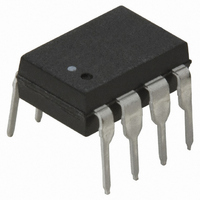HCPL-7800-000E Avago Technologies US Inc., HCPL-7800-000E Datasheet - Page 16

HCPL-7800-000E
Manufacturer Part Number
HCPL-7800-000E
Description
OPTOCOUPLER AMP 100KHZ 8-DIP
Manufacturer
Avago Technologies US Inc.
Type
General Purposer
Specifications of HCPL-7800-000E
Package / Case
8-DIP (0.300", 7.62mm)
Amplifier Type
Isolation
Number Of Circuits
1
-3db Bandwidth
100kHz
Current - Input Bias
500nA
Voltage - Input Offset
300µV
Current - Supply
10.9mA
Current - Output / Channel
16mA
Voltage - Supply, Single/dual (±)
4.5 V ~ 5.5 V
Operating Temperature
-40°C ~ 85°C
Mounting Type
Through Hole
Number Of Channels
Single
Common Mode Rejection Ratio (min)
76 dB
Available Set Gain
18.31 dB
Input Offset Voltage
2 mV
Operating Supply Voltage
5 V
Supply Current
16 mA
Maximum Operating Temperature
+ 85 C
Minimum Operating Temperature
- 40 C
Mounting Style
Through Hole
Supply Voltage (max)
5.5 V
Supply Voltage (min)
4.5 V
Bandwidth
100 kHz
Common Mode Rejection Ratio
76
Current, Supply
10.86 mA (Input), 11.56 mA (Output)
Package Type
DIP-8
Power Dissipation
600 mW
Propagation Delay
4.99 μs
Slew Rate
10
Temperature, Operating, Range
-40 to +85 °C
Time, Fall
2.96 μs
Time, Rise
2.96 μs
Voltage, Gain
8 V/V
Voltage, Input
2 V
Voltage, Input Offset
0.3 mV
Voltage, Noise
31.5 mV
Voltage, Supply
5.5 V
No. Of Channels
1
Isolation Voltage
3.75kV
Optocoupler Output Type
Analog
Input Current
16mA
Output Voltage
3.8V
Opto Case Style
DIP
No. Of Pins
8
Rohs Compliant
Yes
Lead Free Status / RoHS Status
Lead free / RoHS Compliant
Output Type
-
Slew Rate
-
Gain Bandwidth Product
-
Lead Free Status / Rohs Status
Lead free / RoHS Compliant
Other names
516-1481-5
Available stocks
Company
Part Number
Manufacturer
Quantity
Price
Company:
Part Number:
HCPL-7800-000E
Manufacturer:
AVAGO
Quantity:
1 800
Part Number:
HCPL-7800-000E
Manufacturer:
AVAGO/安华高
Quantity:
20 000
Part Number:
HCPL-7800-000E/HCPL7800-000E
Manufacturer:
AVAGO/安华高
Quantity:
20 000
the sense resistor to help distribute the current between
the layers of the PC board. The PC board should use 2 or
4 oz. copper for the layers, resulting in a current carrying
capacity in excess of 20 A. Making the current carrying
traces on the PC board fairly large can also improve the
sense resistor’s power dissipation capability by acting as a
heat sink. Liberal use of vias where the load current enters
and exits the PC board is also recommended.
Note: Please refer to Avago Technologies Application Note 1078 for
additional information on using Isolation Amplifiers.
Sense Resistor Connections
The recommended method for connecting the HCPL-
7800(A) to the current sensing resistor is shown in Figure
18. V
positive terminal of the sense resistor, while V
3) is shorted to GND1 (pin 4), with the power-supply
return path functioning as the sense line to the negative
terminal of the current sense resistor. This allows a single
pair of wires or PC board traces to connect the HCPL-
7800(A) circuit to the sense resistor. By referencing the
input circuit to the negative side of the sense resistor,
any load current induced noise transients on the resistor
are seen as a common-mode signal and will not interfere
with the current-sense signal. This is important because
the large load currents flowing through the motor drive,
along with the parasitic inductances inherent in the
wiring of the circuit, can generate both noise spikes and
offsets that are relatively large compared to the small
voltages that are being measured across the current
sensing resistor.
If the same power supply is used both for the gate
drive circuit and for the current sensing circuit, it is very
important that the connection from GND1 of the HCPL-
7800(A) to the sense resistor be the only return path for
supply current to the gate drive power supply in order
to eliminate potential ground loop problems. The only
direct connection between the HCPL-7800(A) circuit
and the gate drive circuit should be the positive power
supply line.
IN+
(pin 2 of the HPCL-7800(A)) is connected to the
IN-
(pin
Output Side
The op-amp used in the external post-amplifier circuit
should be of sufficiently high precision so that it does not
contribute a significant amount of offset or offset drift
relative to the contribution from the isolation amplifier.
Generally, op-amps with bipolar input stages exhibit
better offset performance than op-amps with JFET or
MOSFET input stages.
In addition, the op-amp should also have enough
bandwidth and slew rate so that it does not adversely
affect the response speed of the overall circuit. The post-
amplifier circuit includes a pair of capacitors (C5 and C6)
that form a single-pole low-pass filter; these capacitors
allow the bandwidth of the post-amp to be adjusted
independently of the gain and are useful for reducing
the output noise from the isola-tion amplifier. Many
different op-amps could be used in the circuit, including:
MC34082A (Motorola), TLO32A, TLO52A, and TLC277
(Texas Instruments), LF412A (National Semiconductor).
The gain-setting resistors in the post-amp should have a
tolerance of 1% or better to ensure adequate CMRR and
adequate gain toler-ance for the overall circuit. Resistor
networks can be used that have much better ratio toler-
ances than can be achieved using discrete resistors. A
resistor network also reduces the total number of compo-
nents for the circuit as well as the required board space.
















